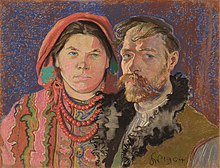Stanisław Wyspiański
Stanisław Mateusz Ignacy Wyspiański (born January 15, 1869 in Cracow , Austria-Hungary ; died November 28, 1907 there ) was a Polish artist and member of the “ Young Poland ” movement.
Life
During a study visit to Paris he was influenced by Art Nouveau , but also by meeting artists from the circle around Paul Gauguin . Likewise, he was probably introduced to the paintings of the Norwegian Edvard Munch through Stanisław Przybyszewski .
Wyspiański worked as a painter and draftsman and designed ornaments, stage decorations and glass windows. The latter include, for example, the windows of the Franciscan Church in Krakow . In addition, he wrote several plays in which he dealt with topics from mythology and sagas, but also from Polish history.
Wyspiański's works can now be found in many Polish museums, including the Wyspiański Museum in Krakow.
Wesele
His best-known piece is “Wesele” (Wedding) from 1901. This was based on the previous year , when his friend Lucjan Rydel actually married a farmer's daughter from Bronowice near Kraków and caused a scandal when it was first performed. In 1973 Andrzej Wajda filmed “Wesele” . The drama in three acts was translated by Henryk Bereska in 1976 and by Karl Dedecius in 1992 .
In the first act, the simple peasants meet with the artists from the Krakow bohemian in the peasant hut . In the second act, historical figures from Poland's past suddenly appear between the wedding guests, making a bitter reckoning with the present. a. the court jester of the Polish kings Stańczyk , the traitorous grand hetman of the Polish crown Franciszek Ksawery Branicki (1730–1819), the legendary Black Knight Zawisza Czarny von Garbów (1379–1428), the leader of the bloody peasant uprising in 1846 Jakub Szela (1787–1860), the legendary Ukrainian prophet Wernyhora and the early deceased Polish painter Ludwik de Laveaux (1868–1894).
The host calls for a popular uprising - but the village boy loses the golden magic horn brought by Wernyhora. At the end of the third act, a rose bush wrapped in straw appears with a violin in hand - an ambiguous symbolic figure - which leads the wedding guests to a hypnotic dance ( ).
Quite unexpectedly, the play, which was originally intended for the closest circle of friends from the Cracow bohemian, became one of the most important dramas in Polish literature. The virtuoso dialogues became the source of idioms that are still in use. Just the first words: “Cóż tam, panie, w polityce? Chińcyki trzymają się mocno? " (Czepiec:" What's up in politics? The Chinese are doing well ?! ") are often quoted.
Works (selection)
Plays
- Warszawianka (German: Warsaw woman - a battle song of the insurgents , 1898)
- Weimar 1829 (fragment, 1904)
- Wesele (German: wedding , 1901)
- The wedding : drama in three acts. Translated from Polish and published by Karl Dedecius , Frankfurt am Main: Suhrkamp 1992 ISBN 3-518-40499-7
- The wedding : drama in 3 acts. From d. Polish. Trans. U. Re-poetry by Henryk Bereska. With e. Essay by Tadeusz Boy-Żeleński . With color photos from the film "The Wedding" by Andrzej Wajda. Leipzig: Reclam 1977
- Noc listopadowa (German: November night , 1904)
- Acropolis (1904)
- Skałka (German: King's Crypt on the Rock , 1907)
Stained glass window
- Designs for the stained glass windows of the Franciscan Church in Kraków
- Designs for stained glass windows that can be seen in the Wyspiański Pavilion 2000 on All Saints' Square in Kraków (erected in 2007, designed by Piotr Ostrowski) depict St. Stanislaus , St. Casimir and Henry II of Silesia
Museums and monuments

- The Wyspiański Museum in Cracow has been located in the Szołayski house at 9 Kanonicza Street in Cracow since November 28, 1983 , as a branch of the Cracow National Museum .
- In 2007, the Wyspiański 2000 Pavilion was unveiled on Wszystkich Świętych Square in Kraków, where three of Wyspiański's stained glass windows are exhibited.
- In 1996, to mark the 50th anniversary of the Austrian-Polish Society on the facade of the Hotel Northern Railway (since 2008 Austria Classic Hotel Wien ) on the Praterstraße 72 in the 2nd Viennese district Leopoldstadt a memorial plaque unveiled for Stanisław Wyspiański which to Wyspiański's connection to the Vienna Secession and to commemorate his stay at the Hotel Nordbahn in the summer of 1904, where Wyspiański wrote his dramatic fragment Weimar in 1829 .
- Opposite the main portal of the Kraków National Museum at Aleja 3 Maja Street, there is a monument to Stanisław Wyspiański, unveiled on November 28, 1982.
- The year 2007 has been declared "Wyspiański Year" by the Polish Sejm .
- The Wyspianski Icefall in Antarctica has been named after him since 1980 .
Movie
- Stanisław Wyspiański in the Internet Movie Database (English)
- Wesele in the Internet Movie Database (English)
Web links
- Literature by and about Stanisław Wyspiański in the catalog of the German National Library
- Union List of Artist Names ® Online
- Wyspiański Museum Krakow
Individual evidence
- ^ Stanisław Mateusz Ignacy Wyspiański. In: sejm-wielki.pl. Retrieved March 26, 2019 (Polish).
- ^ "Wesele" on YouTube
- ↑ Die Hochzeit , edited and translated by Karl Dedecius Suhrkamp 1992, p. 15. (other translation: What's new in politics, sir? Are the Chinese holding on?)
| personal data | |
|---|---|
| SURNAME | Wyspiański, Stanisław |
| ALTERNATIVE NAMES | Wyspiański, Stanisław Mateusz Ignacy (full name) |
| BRIEF DESCRIPTION | Polish artist and member of the "Young Poland" movement |
| DATE OF BIRTH | January 15, 1869 |
| PLACE OF BIRTH | Krakow |
| DATE OF DEATH | November 28, 1907 |
| Place of death | Krakow |








